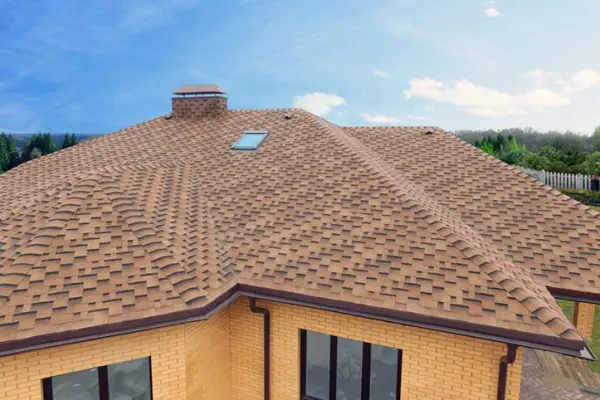Choosing roofing material for a private home is one of the key stages of construction, which directly affects the durability of the entire structure, living comfort, and the aesthetic appearance of the building. According to 2025 research, properly selected roofing can reduce heating and air conditioning costs by up to 30% and last without major repairs from 30 to 100 years depending on the type of material. In the current season, prices for quality roofing materials start from $8 per square meter. Today, we will examine all the criteria for choosing roofing, consider the main types of roofing materials, and provide practical recommendations that will help you determine the ideal option for your home.
Main Criteria for Choosing Roofing for a House
Planning a roof repair, construction of a new building, or thinking about changing the roofing? Honestly, when choosing a material, you need to consider many factors. Not just the price or appearance. A comprehensive solution is important.
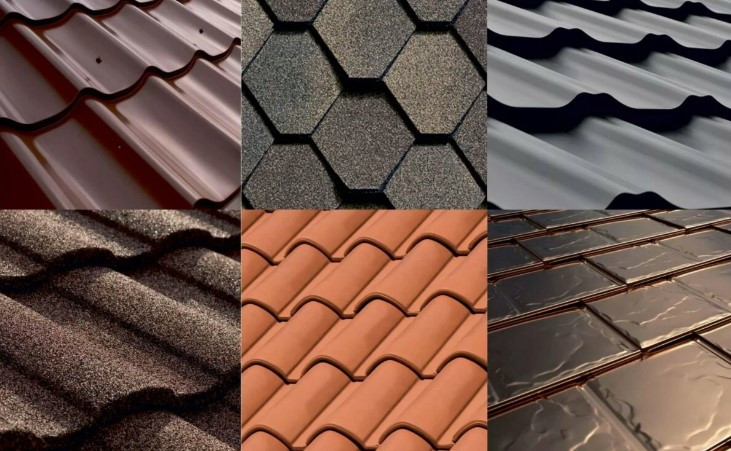 Experts highlight the following key parameters that need to be evaluated before purchasing roofing material:
Experts highlight the following key parameters that need to be evaluated before purchasing roofing material:
- Roof design and roof slope
- Climatic conditions of the region
- Weight of roofing material and load on the truss system
- Service life and repairability of the roof
- Thermal insulation and sound insulation of the roofing
- Resistance to atmospheric effects and ultraviolet radiation
- Roof aesthetics and compatibility with architectural style
- Cost of material and installation of roofing
Last year, I observed a situation in the suburbs of Kyiv, where a homeowner chose a material exclusively based on price, without considering the features of the local climate. The result was a complete roof replacement after two years due to leaks and material deformation during the winter period. Such a repair cost twice the amount of the initial savings. Don't repeat others' mistakes.
When choosing roofing materials, you should follow the rule "measure seven times, cut once." Quality roofing is an investment in the safety and comfort of your home for decades to come. According to our research, savings on roofing materials lead to additional repair costs within the first 5-7 years in 78% of cases.
Types of Roofing Materials and Their Features for a Private Home
To not get lost in the variety of options, let's look at specific types of roofing materials with their real pros and cons. This will help you make an informed choice that you won't have to change in a couple of years.
Metal Tile Roofing — A Practical Solution for Pitched Roofs
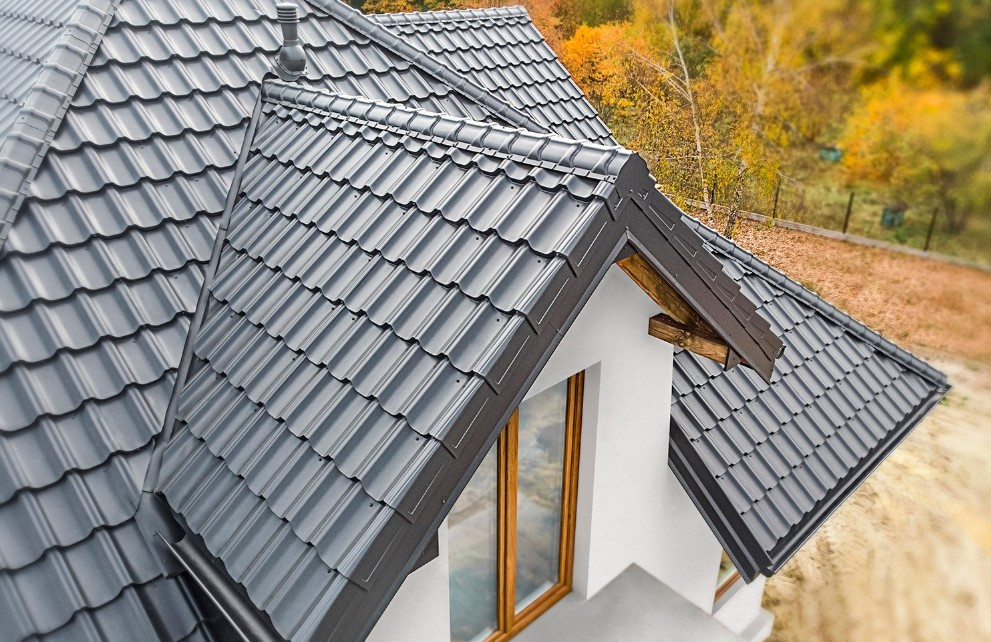 Have you faced the dilemma: you want a reliable roof, but your budget is limited? That's why metal tile roofing has become such a popular choice. With an average price of $8-15 per square meter, it is affordable for most private home builders.
Have you faced the dilemma: you want a reliable roof, but your budget is limited? That's why metal tile roofing has become such a popular choice. With an average price of $8-15 per square meter, it is affordable for most private home builders.
Advantages:
- Light weight (only 4-6 kg/m²) — does not require reinforcement of the truss system
- Durability — 30-50 years with proper installation
- Quick installation — 1.5-2 times faster than installing ceramic tiles
- Wide selection of colors and profiles
- Relatively low cost
Disadvantages:
- Noisy during rain (solved with additional sound insulation)
- Susceptibility to corrosion when the protective layer is damaged
- Color fading over time (especially with budget options)
- Condensation on the inside (solved with proper ventilation)
I've seen many cases where homeowners chose the cheapest metal tiles and faced corrosion after 5-7 years. Choose material with a thickness of at least 0.5 mm and multi-layer coating — such an investment will pay off in just a few years!
Bitumen Shingles — The Perfect Solution for Complex Roof Shapes
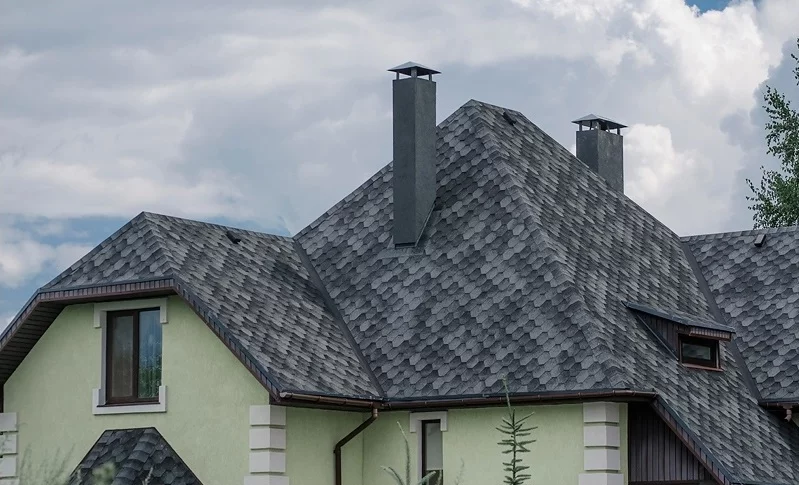 Have you ever wondered why many architects recommend soft roofing when designing houses with complex roof geometry? It's because of its amazing plasticity and ability to cover even the most intricate curves.
Have you ever wondered why many architects recommend soft roofing when designing houses with complex roof geometry? It's because of its amazing plasticity and ability to cover even the most intricate curves.
Advantages:
- Excellent sound insulation — can't even hear heavy rain
- Flexibility — ideal for complex roof shapes and curved surfaces
- Excellent impermeability — completely waterproof when properly installed
- Rich color palette and variety of textures
- Relatively simple repair of individual sections
Disadvantages:
- Average service life (20-30 years) — less than ceramics
- Requires solid sheathing — additional costs
- Less resistant to extreme temperatures
- Difficulty installing at temperatures below +5°C
By the way, according to specialist research, flexible shingles reduce rain noise by 45-50% compared to metal coverings. For those who value silence and peaceful sleep during a downpour, this is a decisive argument!
Ceramic and Cement-Sand Tiles — Classic for Durable Roofing
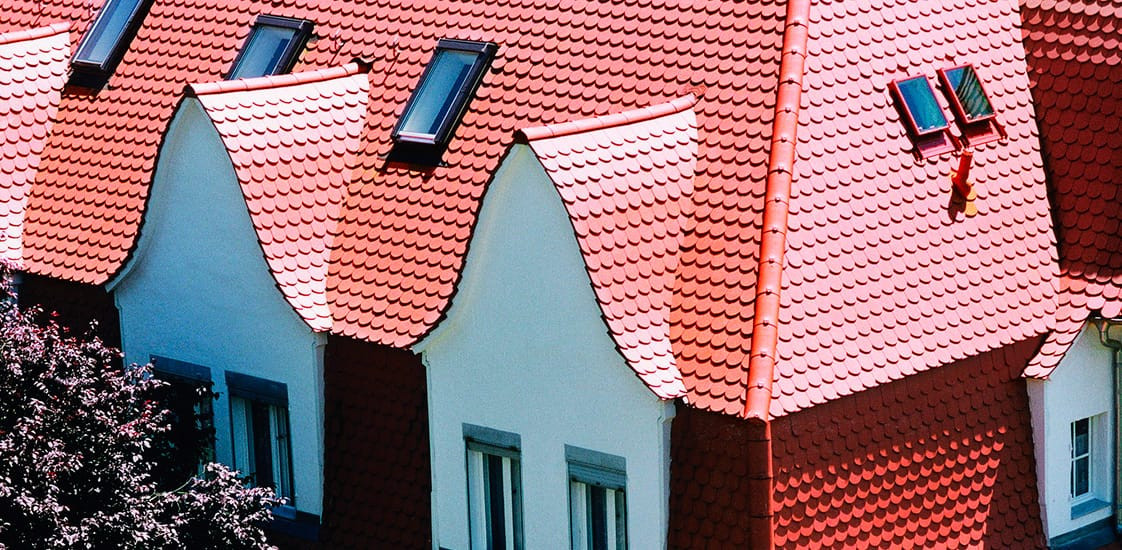 Why do many wealthy homeowners choose ceramic tiles, despite their high cost? The answer is simple — it's an investment not for years, but for decades and even centuries.
Why do many wealthy homeowners choose ceramic tiles, despite their high cost? The answer is simple — it's an investment not for years, but for decades and even centuries.
Advantages:
- Exceptional durability — 80-100+ years for ceramics, 50-70 years for cement-sand
- Excellent thermal and sound insulation
- High fire resistance
- Environmental friendliness of the material
- Resistance to fading and atmospheric effects
- Classic, prestigious appearance
Disadvantages:
- High cost (from $25 per m² for ceramics)
- Large weight (40-65 kg/m²) — requires reinforced truss system
- Complexity and high cost of installation
- Fragility of individual elements under mechanical impact
When building my house in the Kyiv region, I faced a dilemma: pay extra for a reinforced truss system and ceramic tiles or choose a lighter material. The deciding factor was durability — ceramics will serve not only me but also my children!
Corrugated Sheets — Budget Choice for Simple Roof Shapes
 Do you think that an inexpensive material will necessarily be of low quality? Corrugated sheets refute this stereotype. At a price from $6 per square meter, it remains a reliable option for many outbuildings and even residential homes.
Do you think that an inexpensive material will necessarily be of low quality? Corrugated sheets refute this stereotype. At a price from $6 per square meter, it remains a reliable option for many outbuildings and even residential homes.
Advantages:
- The lowest cost among sheet materials
- Quick and easy installation (a house of 100 m² can be covered in 1-2 days)
- Low weight (5-8 kg/m²) — suitable for any truss systems
- Wide selection of colors and profile heights
- Possibility of installation at low temperatures
Disadvantages:
- Limited applicability for complex roof shapes
- Low sound insulation (creates a lot of noise during rain)
- Less durability compared to other materials
- Less presentable appearance
In practice, corrugated sheets are often chosen for garages, outbuildings, or country houses with a simple roof shape. If your budget is limited, but you want to get a reliable roof, choose corrugated sheets with a metal thickness of at least 0.45 mm. Cheap. But effective.
Slate — Time-Tested Economical Option
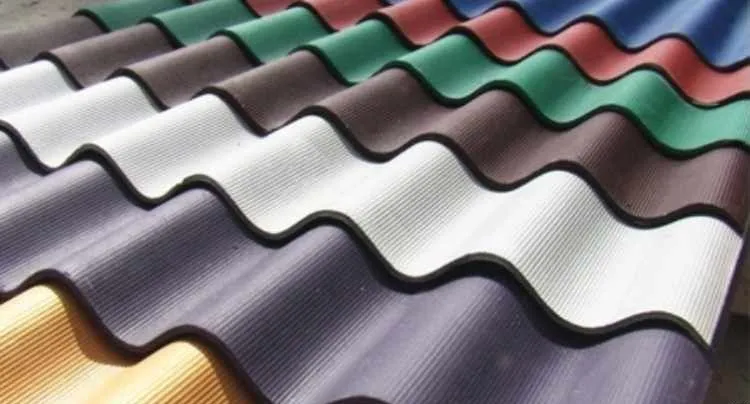 Slate, like a dinosaur in the world of roofing materials, is still found on many roofs. An inexpensive and accessible material with a price from $4 per square meter has a right to exist.
Slate, like a dinosaur in the world of roofing materials, is still found on many roofs. An inexpensive and accessible material with a price from $4 per square meter has a right to exist.
Advantages of slate:
- Low cost
- Ease of installation
- Decent sound insulation
- Service life up to 30 years with proper care
Disadvantages of slate:
- Relatively large weight (15-20 kg/m²)
- Brittleness and fragility under mechanical impacts
- Tendency to form moss and lichen
- Outdated appearance
- Modern versions do not contain asbestos, but old roofs may be environmentally unsafe
In my experience, today slate is chosen mainly for outbuildings or as a temporary solution. For residential houses, there are more modern and aesthetically pleasing alternatives, although in some rural regions, slate is still popular due to its accessibility and ease of installation.
Standing Seam and Copper Roofing — Elite Solutions with a Century-Old History
 Have you ever wondered why many historical buildings still stand under their original roofs? The secret is that for their roofings, standing seam technologies and copper were often used — materials tested by centuries.
Have you ever wondered why many historical buildings still stand under their original roofs? The secret is that for their roofings, standing seam technologies and copper were often used — materials tested by centuries.
Advantages of standing seam roofing:
- Absolute impermeability thanks to seamless connection
- Durability — from 50 to 100 years
- Resistance to extreme weather conditions
- Ability to cover roofs of any complexity and configuration
- Elegant, stylish appearance
Advantages of copper roofing:
- Exceptional durability — more than 100 years
- Formation of protective patina over time
- Does not require painting and special care
- Prestige and unique appearance
- High resistance to corrosion
Disadvantages of elite roofings:
- High cost of material and installation
- Need to attract highly qualified specialists
- Limited availability of quality materials
In one of Kyiv's mansions that I visited in 2023, a copper roof installed in the 1910s is still in excellent condition. Its turquoise patina has become the building's calling card — a real crown of the house, which only becomes more noble with age. Isn't this proof that sometimes the most expensive solution turns out to be the most economical in the long run?
Onduline and Composite Shingles — Modern Alternatives
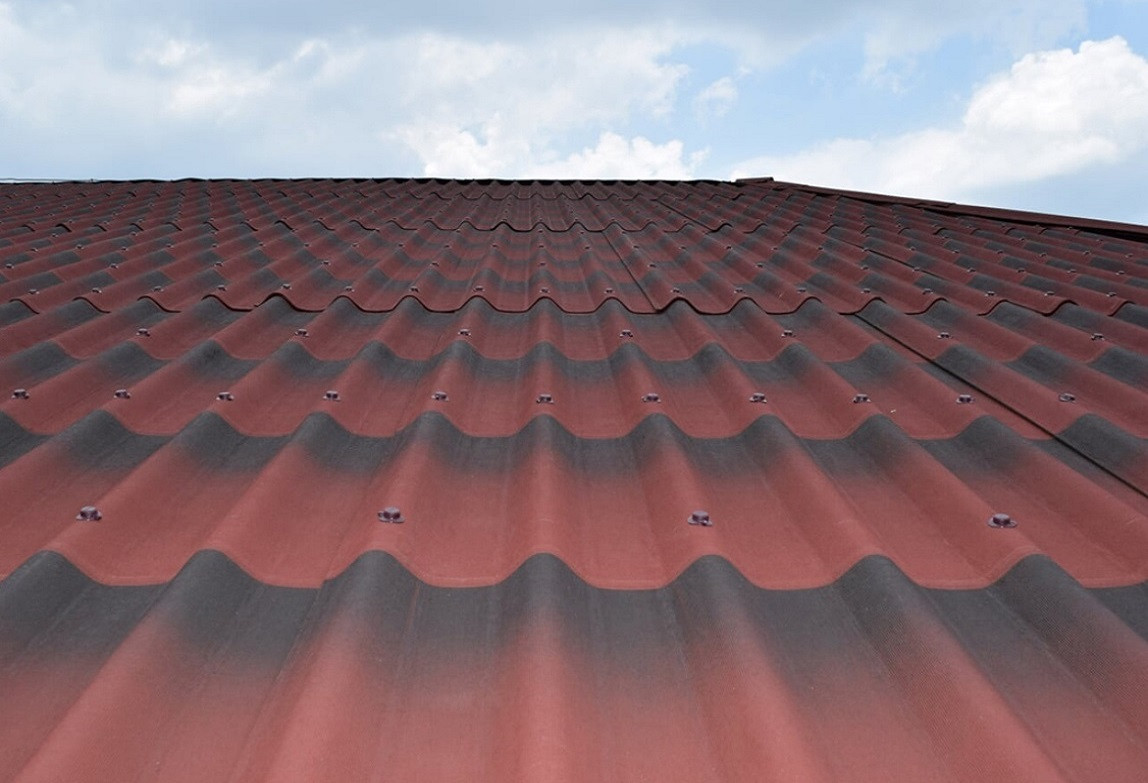 The roofing materials market is constantly evolving. Among the new players, onduline and composite shingles have taken significant positions.
The roofing materials market is constantly evolving. Among the new players, onduline and composite shingles have taken significant positions.
Onduline — a light wavy material based on cellulose fibers impregnated with bitumen. In 2025, the average price is $7-10 per square meter.
Features of onduline:
- Light weight (3-4 kg/m²)
- Simple installation without special tools
- Good sound insulation
- Resistance to corrosion and rot
- Service life about 15-20 years
Composite shingles, like a chameleon in the world of roofing, combine the best qualities of different materials. It consists of a metal base with a multilayer coating of stone chips on an acrylic binder. The cost varies from $15 to $30 per square meter.
Advantages of composite shingles:
- Durability (manufacturers' warranty up to 50 years)
- Aesthetic appearance, imitating natural materials
- Good sound insulation
- Medium weight (6-10 kg/m²)
- Resistance to temperature changes and UV radiation
By the way, in my colleague's latest project, composite shingles were installed on a complex multi-pitched roof of a country house in a forest zone. The material perfectly blended into the surrounding landscape and showed excellent performance characteristics even in conditions of high humidity.
How to Choose the Color of the Roof and Select Material for a House in the Forest
The color of the roof is not just a matter of aesthetics. It affects the energy efficiency of the house, the visual perception of the building, and even its market value. How to avoid making a mistake?
When choosing the color of the roof, consider three key factors:
- Architectural style of the house. For classical styles, traditional shades are suitable: terracotta, brown, gray. Modern architecture allows for bolder solutions: black, anthracite, blue.
- Climatic conditions. In hot climates, light shades that reflect sunlight are preferable. In cold climates — dark colors that better retain heat.
- Surrounding landscape. The house should harmoniously fit into the environment. I've seen many examples where a bright roof looked like a foreign body in a natural setting.
For houses in a forest zone, it's especially important to consider the natural context. The ideal choice would be natural, earthy shades: dark green, brown, bronze. They organically combine with the greenery of trees and help the house "dissolve" in nature.
Roofing material for a house in the forest requires increased attention to the following characteristics:
- Fire safety (preferably using non-combustible materials)
- Resistance to high humidity and biological effects
- Ease of cleaning from leaves, branches, and other natural debris
- Sound insulation (for comfortable stay during rain)
The optimal choice for a house in the forest is metal roofing with high-quality protective coating, composite shingles, or ceramics. They are resistant to moisture, easy to maintain, and have a high level of fire safety.
Choosing Roofing Material Depending on the Roof Type
Whatever roofing material you choose, it must correspond to the design of your roof. Imagine that you bought expensive ceramic tiles for a roof with a small slope — this will lead to leaks and the need for a complete replacement of the covering after a few years! Let's figure out which materials are suitable for different types of roofs.
Pitched Roof: Material Selection Depending on the Slope Angle
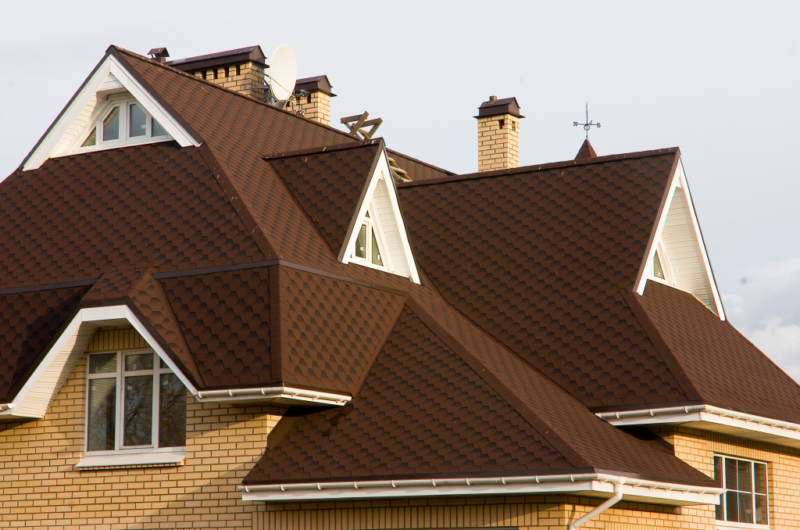 The slope angle of the roof is one of the determining factors when choosing roofing material. Check the correspondence of the selected covering to the minimum allowable slope:
The slope angle of the roof is one of the determining factors when choosing roofing material. Check the correspondence of the selected covering to the minimum allowable slope:
- Low slope (up to 15°):
- Corrugated sheets with high profile
- Standing seam roofing
- Membrane materials
- Medium slope (15-45°):
- Metal tile roofing (from 12°)
- Bitumen shingles (from 11.3°)
- Cement-sand tiles (from 22°)
- Steep slope (more than 45°):
- Ceramic tiles
- Slate roofing
- Copper roofing
In my practice, I often encountered situations where homeowners did not consider this important factor. For example, in 2022, my acquaintance installed metal tile roofing on a roof with a slope of 10°, and after just six months faced leaks in the overlap areas. The roof had to be completely recovered with material suitable for a low slope.
Hip and Mansard Roof: Features of Material Selection
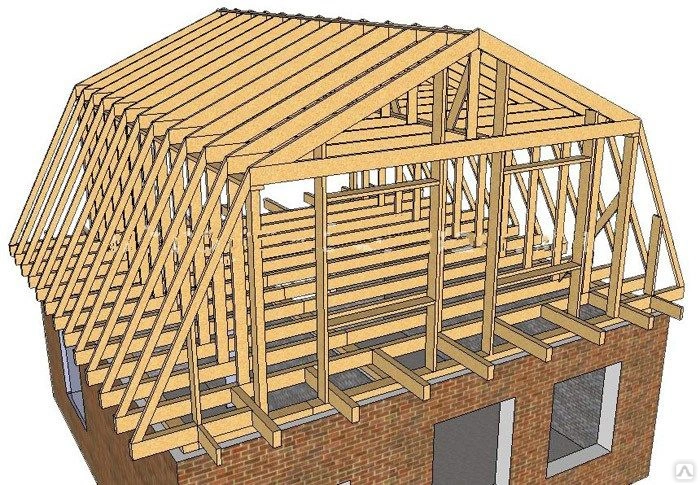 The complex shape of the roof requires a special approach to the choice of roofing material. Think about it: how much waste will there be when cutting rigid sheet materials for a hip roof? This can significantly increase the budget!
The complex shape of the roof requires a special approach to the choice of roofing material. Think about it: how much waste will there be when cutting rigid sheet materials for a hip roof? This can significantly increase the budget!
Best options for a hip roof:
- Bitumen shingles — easily adapts to complex shapes, minimum waste
- Metal tile roofing — subject to precise calculation and cutting
- Standing seam roofing — ideal for complex shapes, but requires the highest qualification of craftsmen
Optimal solutions for a mansard roof:
- Ceramic tiles — provides additional thermal insulation
- Metal tile roofing with enhanced sound insulation
- Composite shingles — combines ease of installation and good thermal insulation properties
In practice, for such complex structures, a combined solution is often used — for example, the mansard part of the roof is covered with bitumen shingles, and the sloped areas with metal tile roofing or ceramics. This allows optimizing costs and using the advantages of different materials.
When we design houses with complex roof geometry, we always recommend clients to choose between bitumen shingles and standing seam roofing. Such materials minimize the number of joints and connections, which is critically important for preventing leaks. According to our statistics, 65% of roof problems in the first 5 years of operation are related to leaks in the places of joints and adjacencies. The correct choice of material for a specific roof shape allows avoiding these problems and saving on potential repairs up to $5000.
Key Components of the Roofing System and Their Significance
Many homeowners focus only on choosing the top layer of the roof, forgetting about the importance of a properly designed roof pie. Do you know that even the most expensive tiles will not save from dampness and mold if proper ventilation and waterproofing are not provided? Let's figure out what a reliable roofing system should consist of.
Truss System and Roof Sheathing: The Foundation of a Reliable Roof
 The truss system is the skeleton of your roof. The safety of the entire house and the durability of the roofing depend on its strength and correct calculation.
The truss system is the skeleton of your roof. The safety of the entire house and the durability of the roofing depend on its strength and correct calculation.
Key points requiring attention:
- Calculation of rafters section depending on the weight of the roofing material
- Determination of rafter spacing (usually 60-100 cm)
- Choice between sparse and solid sheathing
- Treatment of wood with antiseptics and fire retardants
In 2024, composite materials for truss systems appeared on the construction market, which are not subject to rot and deformation. Yes, they cost 2-3 times more than wood, but completely exclude problems associated with humidity and insects.
Sheathing is the deck to which the roofing material is attached. Its type directly depends on the selected covering:
- Solid sheathing (used for: bitumen shingles, standing seam roofing, roll materials)
- Provides a continuous surface for installation
- Increases the rigidity of the structure
- Increases the cost of the roof due to greater material consumption
- Sparse sheathing (used for: metal tile roofing, corrugated sheets, ceramic tiles)
- Saves building material
- Provides additional ventilation
- Reduces the overall weight of the structure
Waterproofing and Thermal Insulation of the Roof: Protection from Moisture and Energy Saving
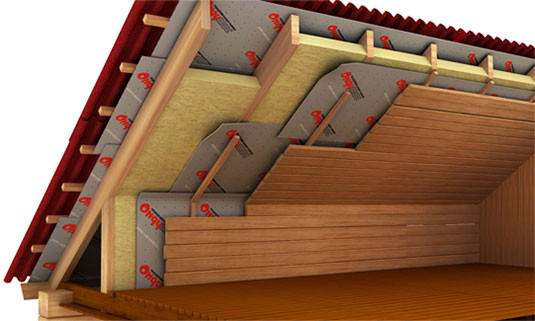 No matter how carefully the top layer of the roof is installed, without proper waterproofing, water will find a way inside the house. Modern waterproofing membranes not only protect against moisture but also have vapor-permeable properties, allowing the structure to "breathe".
No matter how carefully the top layer of the roof is installed, without proper waterproofing, water will find a way inside the house. Modern waterproofing membranes not only protect against moisture but also have vapor-permeable properties, allowing the structure to "breathe".
When considering various thermal insulation options, pay attention to the following characteristics:
- Thermal conductivity coefficient (the lower, the better)
- Water absorption (for roofing, it's critically important to choose materials with a minimum indicator)
- Fire safety
- Resistance to deformation
According to recent studies, up to 35% of heat can escape through an uninsulated roof. In monetary terms — this is approximately $300-500 additional heating costs per year for a house of 150 m². Quality thermal insulation of the roof pays off in 3-4 heating seasons.
Ventilation of the Under-Roof Space: Prevention of Condensation
 Did you know that most roof problems are not related to external leaks, but to condensation that forms inside the roof pie? Without proper ventilation, moisture accumulates, causing rotting of wooden elements and reducing the efficiency of thermal insulation.
Did you know that most roof problems are not related to external leaks, but to condensation that forms inside the roof pie? Without proper ventilation, moisture accumulates, causing rotting of wooden elements and reducing the efficiency of thermal insulation.
Main elements of the roof ventilation system:
- Ventilation gap between the insulation and the roofing material (from 2.5 to 5 cm)
- Holes for air intake in eave overhangs
- Ventilation outlets in the ridge or on the slope
- Aerators for point ventilation
From my own experience, I can say: saving on roof ventilation is very expensive. In 2023, I had the opportunity to participate in the repair of a house where this component was neglected during construction. Just 4 years after construction, the truss system, affected by fungus due to constant high humidity in the under-roof space, had to be completely replaced. The repair cost was about $8000.
| Roofing Type | Durability | Sound Insulation | Thermal Insulation | Ease of Installation | Price/Quality Ratio |
|---|---|---|---|---|---|
| Metal Tile Roofing | 7 | 4 | 5 | 8 | 8 |
| Bitumen Shingles | 6 | 9 | 7 | 7 | 7 |
| Ceramic Tiles | 10 | 8 | 8 | 5 | 6 |
| Cement-Sand Tiles | 8 | 8 | 7 | 5 | 7 |
| Corrugated Sheets | 5 | 3 | 4 | 9 | 9 |
| Copper Roofing | 10 | 5 | 6 | 3 | 5 |
This table will help you compare different roofing materials on five key parameters. Pay special attention to the price/quality ratio and durability — these indicators often determine the real benefit in the long term.
Climatic Features and Their Impact on Roofing Choice
When choosing roofing material, it's necessary to consider the climatic conditions of your region. Think about what weather tests the roof will have to withstand in the coming decades. Heavy rains? Snowy winters? Scorching sun? All these factors require a special approach to the choice of roofing.
Choosing Roofing for Regions with Heavy Snowfall
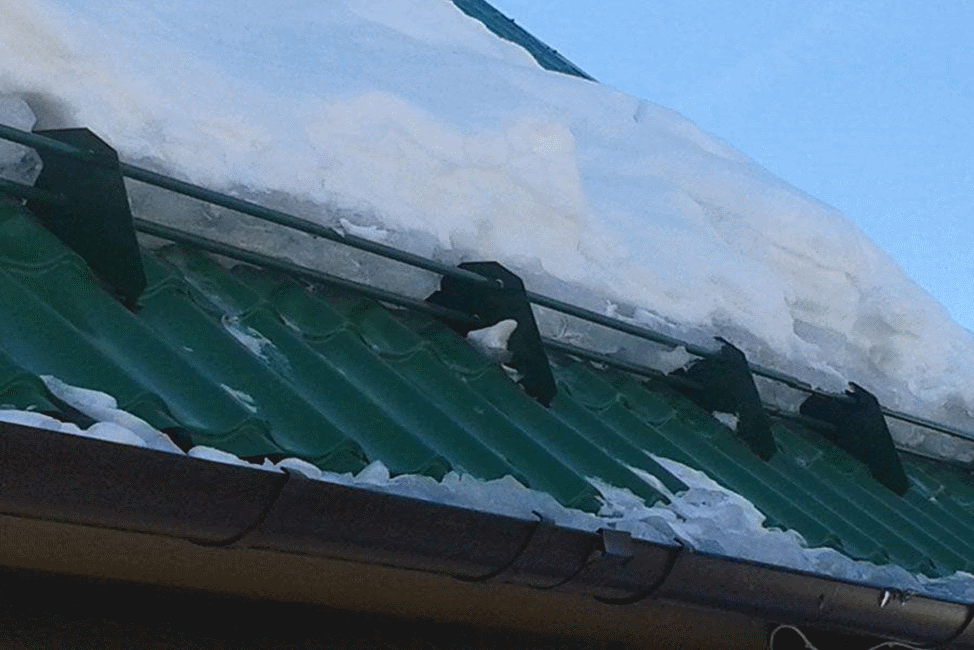 In regions with harsh winters, the roof is subjected to special tests. A meter of snow cover creates a load of up to 300 kg per square meter! Is your roof ready for this?
In regions with harsh winters, the roof is subjected to special tests. A meter of snow cover creates a load of up to 300 kg per square meter! Is your roof ready for this?
What needs to be considered:
- Reinforced truss system to withstand snow load
- Materials with a smooth surface for natural snow descent (metal tile roofing, standing seam roofing)
- Mandatory installation of snow guards to prevent avalanche-like snow descent
- Increased requirements for waterproofing due to snow melting and ice formation
Best materials for snowy regions:
- Metal tile roofing with polymer coating
- Standing seam roofing made of galvanized steel
- Composite shingles with a high strength indicator
Roofing Solutions for Hot Climates: How to Keep Cool
In regions with hot climates, the roof can heat up to +80°C! This not only creates discomfort inside the premises but also leads to increased costs for air conditioning. According to research, properly selected roofing can reduce the temperature in the room by 5-7°C and reduce cooling costs by up to 30%.
Effective solutions for hot climates:
- Light roofing materials, reflecting up to 80% of solar heat
- Ventilated roofing systems with an increased gap
- Thermal insulation with a reflective effect
- Materials with high resistance to ultraviolet
Research by the US Department of Energy shows that so-called "cool roofs" can remain 28°C cooler than ordinary roofs in hot weather, which significantly reduces the load on the air conditioning system and makes the house more comfortable.
Roofing for Regions with Strong Winds
Hurricane-force wind can tear poorly secured roofing off a house in minutes. How to avoid this problem?
Key recommendations:
- Choose materials with a reliable fastening system (standing seam roofing, properly installed ceramic tiles)
- Give preference to aerodynamic roof shapes (hip construction is more resistant to wind loads than gable)
- Use reinforced fastening elements (additional clamps, wind-resistant clips)
- Ensure proper fastening of eave and gable overhangs
Choosing roofing material without considering the climatic features of the region is one of the most common and costly mistakes. According to our data, improperly selected roofing can reduce the service life by 2-3 times and lead to serious damage to the entire house structure. This is especially critical for regions with extreme weather conditions — heavy snowfalls, hurricane winds, or intense solar radiation. Investment in professional consultation ($100-200) can save thousands of dollars on repair and replacement of the roof in the future.
Roof Aesthetics and Compatibility with Architectural Style
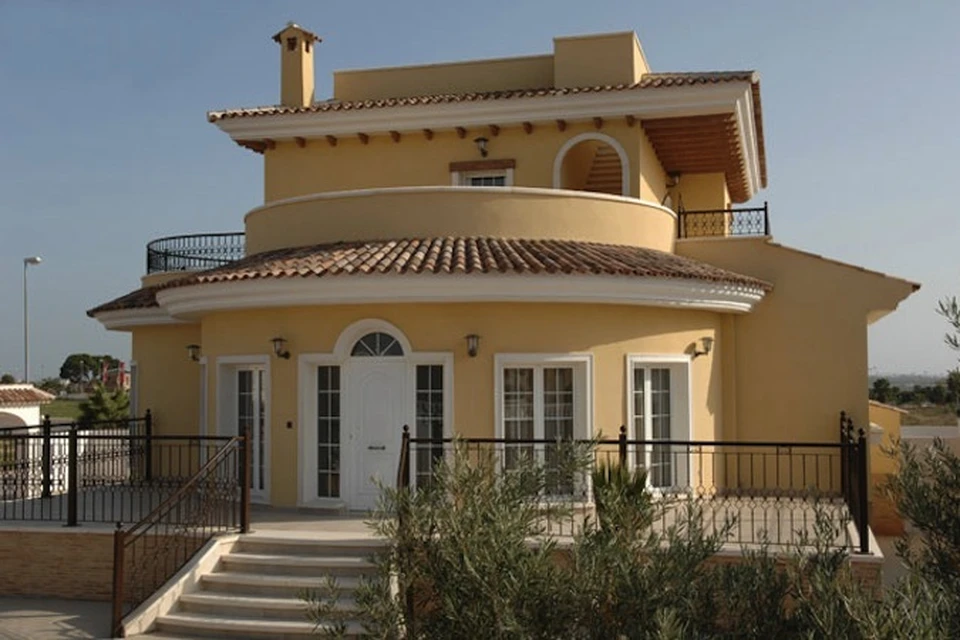 The roof forms up to 30% of the visual perception of a house, so its aesthetic qualities are just as important as its technical characteristics. What image do you want to create? A classic country house, a modern minimalist building, or a luxurious villa? Each style requires its own roofing solution.
The roof forms up to 30% of the visual perception of a house, so its aesthetic qualities are just as important as its technical characteristics. What image do you want to create? A classic country house, a modern minimalist building, or a luxurious villa? Each style requires its own roofing solution.
Walking through the streets of prestigious neighborhoods, I often notice how incorrectly chosen roofing can spoil the overall impression of even an expensive and well-built house. On the other hand, a well-chosen roof covering can turn a modest structure into an architectural gem.
Recommendations for choosing roofing for various architectural styles:
- Classic and traditional styles (colonial, Mediterranean):
- Ceramic tiles (especially natural terracotta shades)
- Cement-sand tiles
- Natural slate
- Modern styles (high-tech, minimalism, modernism):
- Standing seam roofing with clean lines
- Metal tiles with matte coating
- Flat membrane roofs
- Country houses (chalet, half-timbered, country):
- Bituminous shingles with textured surface
- Wooden roofing (shake, shingle)
- Composite tiles imitating natural materials
- Elite mansions (neoclassical, neo-gothic):
- Copper roofing with natural patina
- Slate tiles
- Premium-class ceramics
When choosing the color of the roof, consider not only the style of the house but also the surrounding landscape, the color scheme of the facade and trim. A harmonious combination of all elements is the key to creating an attractive appearance.
In recent years, natural, muted shades have gained particular popularity - terracotta, graphite, olive, wine. They look noble and do not lose relevance over time. Bright, contrasting colors should be chosen with caution - they can quickly go out of fashion.
Practical Case: A Comprehensive Approach to Choosing Roofing
When I decided to build a house in the suburbs of Kyiv in 2021, the question of choosing a roof became very acute. Our family wanted a beautiful and durable roof, but the budget was limited. After consulting with three different specialists and carefully analyzing all factors, we settled on premium-class metal tiles with multi-layer coating. The installation cost $12,000 for a house with an area of 150 m². The decisive factors were: relatively low weight of the material (no reinforcement of the truss system was required), durability (35-year warranty), resistance to heavy snowfall and frost characteristic of our area. After four years, I can say that the decision was correct - the roof withstands all weather conditions perfectly, including the hurricane wind last autumn, when many neighbors with cheaper materials faced problems. And the additional thermal insulation helped reduce heating costs by about 25%.
Conclusion: How to Make a Balanced Decision on Choosing a Roof
Choosing a roofing material is an investment in the safety, comfort, and aesthetic appearance of your home for decades to come. The cost of a roofing system for an average house, including materials, delivery of roofing materials, and installation, varies from $3,000 to $30,000 depending on the chosen solution. To make a balanced decision, I recommend using a comprehensive approach.
Start with an analysis of objective factors:
- Roof design and slope angle
- Climatic conditions of your region
- Load-bearing capacity of the truss system
- Project budget, including not only the cost of material but also installation
Then consider subjective criteria:
- Architectural style of the house and desired appearance
- Priorities for sound insulation and heat retention
- Planned period of use (whether you will live in this house for many years or plan to sell)
Be sure to consult with professionals and study reviews of selected materials. Today, many manufacturers offer seasonal discounts on roofing materials, which can reach 15-20%. As shown in the Consumer Reports roofing guide, even the most expensive and high-quality materials will not give the desired result without proper installation and regular maintenance.
Don't skimp on additional elements of the roofing system: waterproofing, ventilation, thermal insulation. These components often determine the actual service life of the roof and the comfort of living in the house. The right roof is like a good suit: you notice it only when something is wrong with it.
And remember: a properly selected and quality-installed roof is not just a roof over your head, but protection of your home, comfort for your family, and peace of mind for many years. It's worth careful selection and investment.
If you've read all this material and still haven't decided which roof to choose for your home... well, you're hopeless! I'm joking, of course. In fact, I understand you perfectly - the choice is really not easy, especially when it comes to such a long-term and expensive investment. But trust my experience: no matter how much additional information you look for, you're unlikely to find more complete and objective material on choosing a roof. Sometimes you just need to make a decision based on common sense and your priorities. Good luck with your construction!
